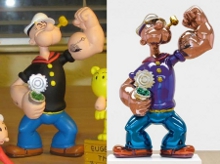 Comic art sales set records last week, but the medium is still on the outside of the art world looking in.
Comic art sales set records last week, but the medium is still on the outside of the art world looking in.I think it was Oscar Wilde who quipped that when rich people get together, they talk about art, and when artists get together, they talk about money. Two notable events in the comics and art world this week give us occasion to talk about both.
Claws for celebration. On May 16, Heritage Auctions reported that the original art to the last page of the October, 1974 issue of the Incredible Hulk hammered at $657,250 (including 19.5% buyers premium) – a record for any original comic art sold in North America. Some of the proceeds of the page, which the seller received as a gift from the artist in the early 1980s, went to the Hero Initiative benefiting creators in need.
The interior page was the work of two journeymen artists, penciller Herb Trimpe and inker Jack Abel, and featured five panels: three of the Hulk slugging it out with Wendigo, one of the battling titans being interrupted by the arrival of a new character designated earlier in the story as "Weapon X," and the final panel revealing that character – a feisty fellow in a yellow striped jumpsuit, sporting a wildlife-themed mask with ears and whiskers, brandishing long metal claws, going by the name "Wolverine."
Wolverine is arguably the most significant character introduced in mainstream comics in the past 40 years, and it’s unsurprising that the original art of his first appearance has set this particular record.
It’s also not surprising that this piece went for about 2000 times the price of a typical Herb Trimpe Hulk page from the 1970s. The item was sold at auction as artwork, but it’s fair to assume that the content rather than the reputation of the artist or the aesthetic qualities of the page is what set the price.
Blow me down! $657,250 is a lot of money for a page of comics original art, but it wouldn’t even qualify as the opening bid for another piece that sold this weekend. Noted artist Jeff Koons, whose “Balloon Dog” realized the highest auction price ever for the work of a living creator ($58 million), sold a 2000 pound steel sculpture of Popeye for a cool $28 million. Casino magnate Steve Wynn was the lucky buyer.
Well, it turns out Wynn could have saved himself $27,999,900 or so and had a nearly identical piece – albeit at reduced size and tonnage – by tracking down a toy figure of the salty sailor man released by Dark Horse in 2002. Amid Amidi at the website Cartoon Brew was tipped off to the rather pronounced similarities between the two pieces by a reader named Alex Kirwan.
According to subsequent reporting on the site, Koons apparently sought and obtained license from King Features to use Popeye as the subject of the feature, although the legality (and propriety) of swiping another artist’s rendition of the figure down to the scalloped edges of the can of spinach in Popeye’s hand is sketchy at best.
Poor artists borrow, rich artists steal. Koons of course isn’t the first to plunder the visual language of comics in the service of high art. Roy Lichtenstein literally made his reputation and fortune swiping the works of John Romita, Irv Novick, Mike Sekowski and dozens of others, as documented on various sites around the web.
Indeed for years the "appropriation" and "recontextualization" of pop culture imagery including comics and other commercial or mass media forms has been the stock in trade of certain members of the fine arts community. Whereas the poor schlemiels who created the source images were earnestly trying to entertain the readers and make a living for their families – and are therefore held in such contempt that they are neither named nor cited as inspirations – the serious artist presents pop culture work to us to be considered as an ironic or detached comment on the nature of commercial iconography, media saturation, infantilization of the culture, or other lofty sentiments.
The late critic and art philosopher Arthur Danto identified this process in his 1964 essay "The Artworld."
...Roy Lichtenstein paints comic-strip panels, though ten or twelve feet high. These are reasonably faithful projections onto a giantesque scale of the homely frames from the daily tabloid, but it is precisely the scale that counts... these things [would not] be artworks without the theories and the histories of the Artworld.
It is presumably this disparity in scale that renders Koons’ recreation of the Dark Horse figure roughly 280,000 times more valuable in the market, just as it is Koons’ reputation within the Artworld that enables him to realize magnitudes more financial rewards than the creator of the original piece.
Real comics art: somewhere in the middle. Despite all of the recent cultural and literary success of comics, it’s somewhere between ironic and sad that these two extremely successful financial transactions from last week still involve comic art that is valuable purely for its collectors’ appeal on one hand, and purely for the snobby Artworld cred that Jeff Koons carries with people like Steve Wynn on the other.
These days just about everyone, even art critics, recognizes there is fine art and Fine Art made by actual comics artists at all points in the history of the medium, from George Herriman to Chris Ware. Some of it is taken seriously in the Artworld, and some of it does pretty well in the market. For example, R. Crumb’s best works, which combine iconic cultural cache, impeccable artistic technique and bona fide artist persona, top out in the low six figures.
In other words, about 20% of a Herb Trimpe/Jack Abel page or a Todd McFarlane Spider-Man cover. And less than 1% of what a world famous artist who can’t be bothered to come up with his own composition and rendering of a pop culture icon. I guess it’s lucky that there’s more to art than how much someone is willing to pay for it.
Rob Salkowitz (@robsalk) is author of Comic-Con and the Business of Pop Culture and a business consultant in Seattle.
The opinions expressed in this column are solely those of the writer, and do not necessarily reflect the views of the editorial staff of ICv2.com.



